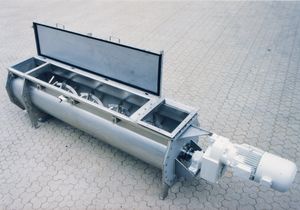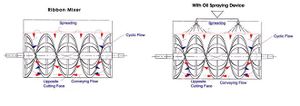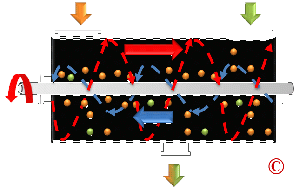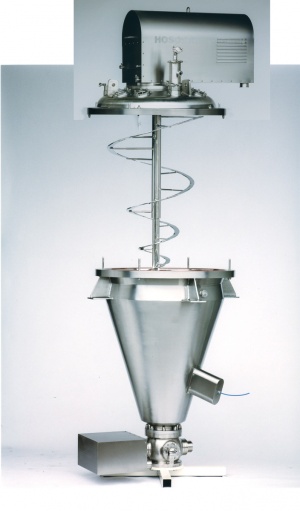Ribbon Blenders
In a Ribbon Blender, a long complicated single paddle is mounted axially and used to disperse the ingredients of the mixture. The ribbon is usually so constructed that the powder near the outside of the container is moved in one direction, whereas in the middle it is moved in the opposite direction. Ribbon mixer are available from several manufacturers and they all have their own type of ribbon. The reader should note that many of the companies mentioned with respect to a particluar type of mixer in the discussion often make other type of mixers, as set out in their catalogs.
Industrial use
Ribbon mixers are a basic industrial mixing tool. They consist, basically, of a trough-shaped casing (usually 2 to 3 times longer than it is wide) with a semicircular bottom, fitted with a horizontal longitudinal shaft on which are mounted arms supporting a combination of ribbon blades, paddles or helical screws set at a fairly close clearance to the semicircular mixer body so that no layer of material remains on the bottom of the mixer. The most effective design of ribbon layout is the double spiral in which the outer ribbon moves the product in one direction and the inner ribbon moves it in the opposite direction. This creates axial flow and prevents any buildup of material moved by the blades as they rotate is relatively small so that mixing times can be long. The capacity of the mixer should not be exceeded otherwise the ribbon and/or blades are not effective and the surface layers of the powder do not get adequately mixed.
Ribbon mixers are normally operated at room temperature but they may be jacketed for steam heating (at atmospheric pressure)or water cooling, should this be called for .
Although ribbon mixers are relatively standard in design there are many modifications and commercial design options available depending on:
- materials characteristics
- production requirements, particularly batch size and working conditions
- machine characteristic such as loading and unloading facilities
One does not normally fill this type of mixer to more than 50% of the available volume. Normally the capacity of this type of mixer is restricted to anupper limit of 15 m.
Sometimes, to improve the dispersion of ingredients in ribbon mixers, the ribbon blades are built to be close to the cylindrical wall to give high shearing. Sometimes the ribbons are also fitted with rubber wipers to ensure complete intermingling of the ingredients by lifting any packed material near the wall into the middle of the ribbon ensemble. It is difficult to predict the scale-up performance if one attempts to increase mixing captcity by going to a larger mixer of the same type.
Type of Ribbon Blenders
There are a number of different type of mixers used in the feed industry with the most widely used being:
- Vertical Ribbon Blenders – Used in small farms, they consist of a vertical screw which takes material to the top where it falls back down again, and repeats that process to mix materials
- Horizontal Ribbon Mixers – Consisting of paddles or blades attached to a horizontal rotor, these mixers are normally mixer and can usually have a higher consistent homogeneity and short mixing times.



